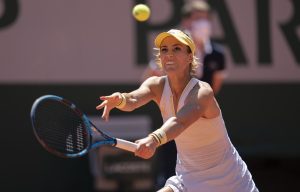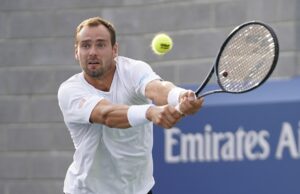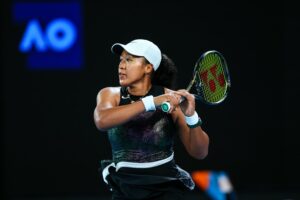Countdown to Roland Garros: In the third part of our series building up to the French Open, Last Word on Tennis looks at the five greatest French Open Women’s Champions.
In compiling a list of the five greatest French Open Women’s Champions, it is perhaps most instructive to consider who doesn’t make it – great champions and multiple Roland Garros champions such as Justine Henin (a four-time winner) and Serena Williams (who has triumphed three times in Paris). The fact they do not merit inclusion is a testament to the enduring greatness of those who do. Here are the five best French Open Women’s Champions.
- HELEN WILLS (Winner of four French Opens: 1928, 1929, 1930 and 1932)
Helen Wills was also known as Helen Wills Moody, after her eight-year marriage to Fred Moody, which ended when she divorced him in 1937. It is entirely appropriate that she dropped the name “Moody” and reverted to being “Helen Wills” (at least until she married again to Aidan Roark, an Irish polo player, who she remained married to until they divorced in the 1970s). That was because she was anything but moody or mercurial, and instead was famed for her sheer will to win. As she later wrote in her autobiography, “I had one thought and that was to put the ball across the net.” She exhibited a single-mindedness demonstrated only by the very greatest tennis players and it made her the first world-famous sportswoman.
In appraising Wills’s achievements in Paris, it is worth considering that her haul of four French Opens is far inferior to her collection of Wimbledon and US titles (eight and seven respectively). At a time before jet travel, when the Australian Open was very much the runt of the Grand Slam litter and largely competed for and won by Australian players, Wills dominated the “big three” tennis tournaments for more than a decade. She initially broke through in the Majors at her native US Open, which she first won in 1923 when she was only 18, and then went on to exert a dominance on the Wimbledon grass that every subsequent Wimbledon women’s champion, including the great Martina Navratilova, could only dream of, winning four titles in a row between 1927 and 1930, and another four titles in the rest of the 1930s. It took her a little longer to make her mark in Paris, but when she did she soon dominated that Major too.
Wills’s run of French successes came after her predecessor as the Queen of Paris, Suzanne Lenglen (more on her later), finally turned professional in 1926 and thus was unable to continue appearing at Grand Slam events. As a result, Wills and Lenglen never met at Roland Garros and indeed only played each other once in their entire career (in a non-Major event in Cannes that was won by Lenglen). Nevertheless, Wills filled the void left by the great Lenglen and transplanted her dominance on grass to clay. Not one of her four successful French finals went beyond two sets, with her first victory in 1928, against Britain’s Eileen Bennett Whittingstall, proving particularly overwhelming, as she won 6-1, 6-2. Indeed, the only surprising part of Wills’s winning performances in Paris was that she did not continue them into the 1930s, preferring instead to concentrate on the US Open and Wimbledon. Perhaps she felt the absence of Lenglen, her greatest rival, too keenly, or perhaps the series of illnesses and injuries that she suffered in the second half of her career sapped her willingness to continue on clay (rather like Roger Federer now). If she had maintained her winning record at Roland Garros, she would almost certainly be regarded as the greatest French Open Women’s Champion, as opposed to No. 5.
- MARGARET COURT (Winner of five French Opens: 1962, 1964, 1969, 1970, 1973)
Just as Helen Wills began her own era of domination of tennis’s Majors by winning her native US Open several times before winning abroad, so Margaret Court won the Australian Open a couple of times before going on to conquer the rest of the tennis world. Indeed, Court’s first French Open win in 1962 made her the first Australian woman to win a Grand Slam event outside of Australia and immediately elevated her above previous Australian women’s champions such as Daphne Akhurst and Coral Buttsworth. But she didn’t stop there, as she went on to claim a total of five French Open wins over the next decade or so, in the process establishing herself as the Queen of Tennis even as her compatriot, Rod Laver, was proving himself to be the undoubted King.
Court’s first victory in the final of the French Open was against another Australian woman, Lesley Turner Bowery, and the two women also contested the 1965 final, when Turner Bowery gained her revenge by winning. However, fine player though Turner Bowery was, the most memorable of Court’s four other French Open wins came against two of the greatest female players ever, Brazil’s Maria Bueno and the USA’s Chris Evert.
Long before Gustavo Kuerten was carving love hearts in the Parisian clay, Maria Bueno was the first Brazilian to capture French hearts. However, she never won in Paris and the only time she reached the final, in 1964, she faced the magnificent Margaret, who triumphed in three sets, racing away with the second and third sets after Bueno had won a terrifically tight first set 7-5. Then, in 1973 Court beat a superstar-to-be, Chris Evert, in a titanic three-set match that really represented a changing of the guard at Roland Garros. It was Court’s final French title and her penultimate Grand Slam title (she won the US Open later in 1973), before Evert and Martina Navratilova rose up to challenge and eventually end her dominance of women’s tennis.
Court’s greatest achievement, of course, was the calendar Grand Slam (i.e. a genuine Grand Slam) in 1970, and as with most Grand Slams or attempted Grand Slams Paris always looked like the main obstacle to overcome. Typically, Court overcame it with relative ease, sweeping aside the gifted Americans Rosie Casals and Julie Heldman in the quarterfinal and semi-final respectively, before dispatching Helga Niessen of West Germany in straight sets in the final. It was a superb display, which allowed her to retain her French title and set her on the way to becoming the first woman to win all four Majors in a single year.

- STEFFI GRAF (Winner of six French Opens: 1987, 1988, 1993, 1995, 1996 and 1999)
Of course, Steffi Graf went one better than Margaret Court in 1988, when she won the so-called “Golden Slam”, by adding the Olympic singles title in Seoul to her triumphs in the four Majors that year. Indeed, in 1988 Graf also produced the single most dominant performance by any tennis player – male or female – in a Grand Slam final when she “double-bagelled” Natasha Zvereva 6-0, 6-0 in Paris. Fortunately for tennis fans, her five other triumphs at Roland Garros were achieved after far more competitive finals.
Indeed, Graf’s first French win, in 1987, was not only her first Major win full-stop but arguably her greatest performance in any Paris final. She defeated Martina Navratilova, who was then the World No.1 and a two-time French Open champion, 6–4, 4–6, 8–6. The third set in particular proved a classic contrast of styles, with Graf’s baseline battery of winners finally overcoming Navratilova’s “net-rushing,” or serve-and-volley tactic. However, it was not Navratilova who was to provide Graf’s sternest tests in France over the next decade but two other players, who were themselves multiple French Open champions, Arantxa Sánchez Vicario and Monica Seles. In fact, after retaining the French title in 1988, Graf was to lose three of the next four finals at Roland Garros to Sanchez Vicario and Seles (losing two finals to Seles and once to Sanchez Vicario). Graf finally reclaimed the French title in 1993, when Seles, who had been stabbed on court a month earlier in Hamburg by an obsessive Graf fan, was unable to add to her three successive French titles. In Seles’s continuing absence from the women’s game (it was more than two years before she finally returned to the women’s tour), it was Sanchez Vicario who provided the toughest opposition, coming runner-up to Graf in both 1995 and 1996.
Graf’s fifth and final French Open win came in 1999, when she defeated the “new champion on the block”, Martina Hingis, in an epic match that ranks among the finest French Open women’s finals. Hingis, who by that point had replaced Graf as the World No.1, took the first set, but Graf displayed all her technical brilliance and competitive ardour to take the next two sets and claim her final French title, which turned out to be her final Grand Slam win of all.
- CHRIS EVERT (Winner of seven French Opens: 1974, 1975, 1979, 1980, 1983, 1985 and 1986)
The winner of a truly magnificent seven French Open singles titles, which remains a record, Chris Evert can legitimately claim to be the greatest female French Open champion of them all. It is only the fact that those seven titles were won over a period of 12 years, rather than in a concentrated seven-year burst, that denies her the top spot in this list. Nevertheless, she is undoubtedly one of the very finest female clay court players ever and certainly in the top two French women’s champions of all time.
During their great rivalry in the 1970s and 1980s, which remains the greatest rivalry in women’s tennis ever and arguably only second to that of Federer and Nadal in all of tennis history, Roland Garros was to Evert what Wimbledon was to Martina Navratilova, namely her “go-to” Grand Slam, which she could always count on being competitive in even when she was struggling on other surfaces in other Majors. Her baseline game was perfect for clay and although she lost her first French Open final to Margaret Court in 1973, she went on to win the next two finals, including in 1975, when she defeated Navratilova in three sets, including a 6-1 third set.
Evert’s French Open successes seemed to come in bursts, and so it was another four years before she made the Paris final again, when she defeated Australia’s Wendy Turnbull in straight sets (indeed, for the loss of just two games), but she then retained the title in 1980, beating Romania’s Virginia Ruzici, who had stunned the tennis world by winning the title in 1978. As the 1980s progressed, however, and Navratilova seemed to edge ahead in her rivalry with Evert by winning numerous Majors, particularly at Wimbledon, it seemed that Evert had lost her previously secure footing on clay and consequently was destined to remain in Navratilova’s shadow forever.
That is what makes Evert’s mid-1980s run at the French Open so impressive. First, she won the 1983 tournament by beating Mima Jaušovec of Yugoslavia (who was no slouch, having won the title in 1977), but then, after losing to Navratilova in the 1984 final, she hit back to take the next two French titles, with the 1985 final proving particularly memorable. Indeed, Evert always maintained that it was the single most satisfying win of her career, coming, as it did, after a period of apparently unending Navratilova dominance. For good measure, she repeated the feat in the 1986 final, which was to prove her final Grand Slam victory over Navratilova or anyone else. Nevertheless, by winning three French Open titles out of four at the peak of Navratilova’s powers, Evert had proved that on clay she was not only Navratilova’s equal but actually her superior.
- SUZANNE LENGLEN (Winner of six French Opens: 1920, 1921, 1922, 1923, 1925 and 1926)
The only woman who can beat Chris Evert as the true Queen of Paris and the greatest French Open Women’s Champion is, fittingly, the great French player, Suzanne Lenglen. Lenglen may have won one French title less than Evert but she exerted a total grip on the clay court tennis of her era that even the mighty Chrissie could not emulate. For that, as much as for her stylish play on court and her bravura fashion sense off it, Lenglen deserves to be regarded as the finest female French Champion of all time.
Like her compatriot Marion Bartoli nearly a century later, and indeed like many great male or female tennis players, Lenglen was initially coached by her father, Charles. Indeed, legend has it that Charles virtually ordered his asthmatic daughter to play tennis in order to improve her health. Although Lenglen continued to be plagued by respiratory problems for the rest of her life, she still went on to dominate the women’s game in the decade after World War One, especially at Roland Garros, and it was only the fact that she turned professional in 1926 that prevented her from continuing her domination for far more than a decade.
Lenglen won six French titles in the 1920s, including four in a row from 1920, when the tournament resumed after the ravages of World War One. Because of problems with her asthma in 1924, she was unable to defend her title that year, but as if to remind everyone of her utter superiority to every other female tennis player of her era she won two more titles in 1925 and 1926.
Of course, Lenglen was not only apparently unbeatable on clay but on other surfaces, including grass. In a foreshadowing of Bjorn Borg’s brilliance in the 1970s, when he somehow dominated both the French Open and Wimbledon, Lenglen also won the Wimbledon singles title six times in the late teens and early 1920s, again only missing out in 1924 because of her breathing difficulties. Given how extraordinary Lenglen was as an asthmatic player, if she had been able to enjoy the anti-asthmatic treatments that became commonplace after her playing career was over, she would surely have set a Grand Slam singles record that even Margaret Court would have struggled to match.
However, for all her mastery of grass at Wimbledon, it is with the red clay of Roland Garros that Lenglen will forever be synonymous, because her influence on French tennis can hardly be overstated. Not only did she win the French Open singles title six years out of seven, but in the process she helped to popularise the game in France, giving it a status that remains to this day, when France can still claim to be the greatest tennis nation, at least in terms of playing numbers. She effectively laid the groundwork for the rise of the great French male players of the 1920s, including Rene Lacoste and Jean Borotra, who would go on to dominate the French Open Men’s Singles Championship as Lenglen had dominated the women’s event, before extending that domination to the Davis Cup, which they won six times in a row between 1927 and 1932.
Lenglen died tragically young in 1938, aged just 39. After all her problems with asthma, she eventually died of leukemia, barely a month after being diagnosed with the cancer. Before she died, however, she had done more than any other woman, certainly before and arguably since, to raise the profile of women’s tennis, such that tennis remains the only sport that can legitimately claim to be played by both men and women equally at the highest levels (including equal prize money at Grand Slams). For that, she is not only the finest French Open Women’s Champion but perhaps the most important woman tennis player ever.
Enjoy articles looking back at all-time best players and tennis history in general? Make sure to check out our page devoted to stories appreciating historic achievements in tennis.
Main Photo:






